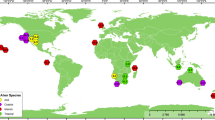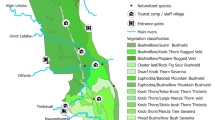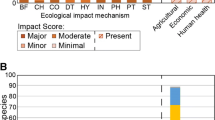Abstract
Minimising the spread and impact of alien plants is a crucial component of land management for biodiversity conservation. Alien plant management typically focuses on either controlling selected alien species (‘species-led’), or on minimizing invasions within selected biodiversity or cultural assets (‘asset-led’). Here, we compare and combine species- and asset-led approaches to prioritise alien plant management activities in the world’s largest Mediterranean-climate woodland, located in south-western Australia. Our species-led approach focused on identifying aliens likely to be increasingly problematic in future with a changing climate. Our asset-led approach used comprehensive flora survey data to identify key predictors of contemporary alien presence, with the purpose of minimising alien occurrence across the asset of a relatively little-disturbed landscape. Most aliens were associated with climates more mesic than are predicted to occur in the region in future. A limited range of alien taxa (12 %) are predicted to be both highly invasive in the future and feasibly eradicated or contained, and it is these that should be subject to species-led management. A consistent set of management-related predictors of contemporary alien presence were identified, including closer proximity to towns, buildings and water points, and occurrence on a geology and soil type associated with prospective mineral deposits. Addressing the highest management priorities of each approach would appear to be a complementary and parsimonious way forward for regional-scale alien management for biodiversity conservation, as this tackles the processes associated with contemporary alien spread (asset-led approach) while taking a precautionary approach to pre-empt future problematic invasions (species-led approach).



Similar content being viewed by others
References
Beard JS (1990) Plant life of Western Australia. Kangaroo Press, Kenthurst
Bureau of Meteorology (2014) Climate data online. http://www.bom.gov.au/climate/data/index.shtml. Accessed 6 Feb 2014
Catford JA, Jansson R, Nilsson C (2009) Reducing redundancy in invasion ecology by integrating hypotheses into a single theoretical framework. Divers Distrib 15:22–40
Chevan A, Sutherland M (1991) Hierarchical partitioning. Am Stat 45:90–96
Chong GW, Otsuki Y, Stohlgren TJ, Guenther D, Evangelista P, Villa C, Waters A (2006) Evaluating plant invasions from both habitat and species perspectives. West North Am Nat 66:92–105
Cox RL, Underwood EC (2011) The importance of conserving biodiversity outside of protected areas in Mediterranean ecosystems. PLoS One 6(1):e14508. doi:10.1371/journal.pone.0014508
Department of Environment and Conservation (DEC) (2010) A biodiversity and cultural conservation strategy for the Great Western Woodlands. DEC, Perth
Department of Environment and Conservation (DEC) (2013) Great Western Woodlands Draft strategic weed and Feral animal management plan. DEC, Perth
Department of Parks and Wildlife (DPaW) (2013) Weed prioritisation process for DPaW. http://www.dpaw.wa.gov.au/plants-and-animals/plants/weeds/156-how-does-dpaw-manage-weeds. Accessed 10 Feb 2014
Duursma DE, Gallagher RV, Roger E, Hughes L, Downey PO, Leishman MR (2013) Weed futures: determining current and future weed threats in Australia. http://www.weedfutures.net/. Accessed 22 Apr 2015
Elton CS (1958) The ecology of invasions by animals and plants. Methuen, London
Fensham RJ, Fairfax RJ (2008) Water-remoteness for grazing relief in Australian arid-lands. Biol Conserv 141:1447–1460
Fletcher CS, Westcott DA (2013) Dispersal and the design of effective management strategies for plant invasions: matching scales for success. Ecol Appl 23:1881–1892
García RA, Pauchard A, Escudero A (2014) French broom (Teline monspessulana) invasion in south-central Chile depends on factors operating at different spatial scales. Biol Invasions 16:113–124
Gassó N, Sol D, Pino J, Dana ED, Lloret F, Sanz-Elorza M, Sobrino E, Vilà M (2009) Exploring species attributes and site characteristics to assess plant invasions in Spain. Divers Distrib 15:50–58
Gavier-Pizarro GI, Radeloff VC, Stewart SI, Huebner CD, Keuler NS (2010) Rural housing is related to plant invasions in forests of southern Wisconsin, USA. Landsc Ecol 25:1505–1518
Gaynor A (2005) ‘Like a good deed in a naughty world’: gardens on the Eastern Goldfields of Western Australia. Aust Humanit Rev 36. http://www.australianhumanitiesreview.org/archive/Issue-July-2005/11Gaynor.html. Accessed 8 May 2014
Gibson N, Yates CJ, Dillon R (2010) Plant communities of the ironstone ranges of south Western Australia: hotspots for plant diversity and mineral deposits. Biodivers Conserv 19:3951–3962
Gosper CR, Yates CJ, Prober SM, Williams MR (2011) Fire does not facilitate invasion by alien annual grasses in an infertile Australian agricultural landscape. Biol Invasions 13:533–544
Grice AC, Ainsworth N (2003) Sleeper weeds—a useful concept? Plant Prot Q 18:35–39
Hobbs RJ, Huenneke LF (1992) Disturbance, diversity, and invasion: implications for conservation. Conserv Biol 6:324–337
Hopper SD, Gioia P (2004) The southwest Australian floristic region: evolution and conservation of a global hot spot of biodiversity. Annu Rev Ecol Evol Syst 35:623–650
Landsberg J, James CD, Morton SR, Müller WJ, Stol J (2003) Abundance and composition of plant species along grazing gradients in Australian rangelands. J Appl Ecol 40:1008–1024
Mac Nally R (1996) Hierarchical partitioning as an interpretative tool in multivariate inference. Aust J Ecol 21:224–228
Mac Nally R (2002) Multiple regression and inference in ecology and conservation biology: further comments on identifying important predictor variables. Biodivers Conserv 11:1397–1401
Martin T, Murphy H, Liedloff A (2010) Invasive species and climate change: a framework for predicting species distribution when data are scarce. CSIRO Climate Adaption Flagship Working Paper Number 13G. http://www.csiro.au/resources/CAF-working-papers. Accessed 10 Feb 2015
McDonald CJ, McPherson GR (2011) Fire behavior characteristics of buffelgrass-fueled fires and native plant community composition in invaded patches. J Arid Environ 75:1147–1154
McLeod AI, Xu C (2011) bestglm: best subset GLM. http://www.R-project.org/. Accessed 6 May 2014
New South Wales (NSW) Department of Primary Industries (DPI) (2008) New South Wales invasive species plan 2008–2015. NSW DPI, Orange
Nistelberger H, Byrne M, Coates D, Roberts JD (2014) Strong phylogeographic structure in a millipede indicates Pleistocene vicariance between populations on banded iron formations in semi-arid Australia. PLoS One 9(3):e93038. doi:10.1371/journal.pone.0093038
Panetta FD, Cacho OJ (2012) Beyond fecundity control: which weeds are most containable? J Appl Ecol 49:311–321
Panetta FD, Lawes RM (2005) Evaluation of the performance of weed eradication programs: the delimitation of extent. Divers Distrib 11:435–442
Prober SM, Thiele KR, Rundel PW, Yates CJ, Berry SL, Byrne M, Christidis L, Gosper CR, Grierson PF, Lemson K, Lyons T, Macfarlane C, O’Connor MH, Scott JK, Standish RJ, Stock WD, van Etten EJB, Wardell-Johnson GW, Watson A (2012) Facilitating adaptation of biodiversity to climate change: a conceptual framework applied to the world’s largest Mediterranean-climate woodland. Clim Change 110:227–248
Pyšek P, Jarošík V, Hulme PE, Pergl J, Hejda M, Schaffner U, Vilà M (2012) A global assessment of alien invasive plant impacts on resident species, communities and ecosystems: the interaction of impact measures, invading species’ traits and environment. Glob Change Biol 18:1725–1737
Randall RP (2012) A global compendium of weeds, 2nd edn. Department of Agriculture and Food, Perth
Richardson DM, Pyšek P (2008) Fifty years of invasion ecology—the legacy of Charles Elton. Divers Distrib 14:161–168
Richardson DM, Allsopp N, D’Antonio CM, Milton SJ, Rejmánek M (2000a) Plant invasions—the role of mutualisms. Biol Rev Camb Philos Soc 75:65–93
Richardson DM, Pyšek P, Rejmánek M, Barbour MG, Panetta DF, West CJ (2000b) Naturalization and invasion of alien plants: concepts and definitions. Divers Distrib 6:93–107
Schut AGT, Wardell-Johnson GW, Yates CJ, Keppel G, Baran I, Franklin SE, Hopper SD, Van Niel KP, Mucina L, Byrne M (2014) Rapid characterisation of vegetation structure to predict refugia and climate change impacts across a global biodiversity hotspot. PLoS One 9(1):e82778. doi:10.1371/journal.pone.0082778
Scott JK, Webber BL, Murphy H, Ota N, Kriticos DJ, Loechel B (2014) AdaptNRM weeds and climate change: supporting weed management adaptation. http://adaptnrm.csiro.au/wp-content/uploads/2014/08/Adapt-NRM_M2_WeedsTechGuide_5.1_LR.pdf. Accessed 10 Feb 2015
Simberloff D, von Holle B (1999) Positive interactions of nonindigenous species: invasional meltdown? Biol Invasions 1:21–32
R Core Team (2013) R: a language and environment for statistical computing. R Foundation for Statistical Computing, Vienna, Austria. http://www.R-project.org/. Accessed 6 May 2014
Thompson WA, Allen J (2013) Flora and vegetation of greenstone formations of the Yilgarn Craton: southern Bullfinch Greenstone Belt. Conserv Sci West Aust 8:295–312
Todd SW (2006) Gradients in vegetation cover, structure and species richness of Nama-Karoo shrublands in relation to distance from livestock watering points. J Appl Ecol 43:293–304
Walsh C, Mac Nally R (2013) Package hier. part: hierarchical partitioning, version 1.0-4. http://cran.r-project.org/. Accessed 6 May 2014
Watson A, Judd S, Watson J, Lam A, Mackenzie D (2008) The extraordinary nature of the Great WesternWoodlands. The Wilderness Society, Perth
Webber BL, Yates CJ, Le Maitre DC, Scott JK, Kriticos DJ, Ota N, McNeill A, Le Roux JJ, Midgley GF (2011) Modelling horses for novel climate courses: insights from projecting potential distributions of native and alien Australian acacias with correlative and mechanistic models. Divers Distrib 17:978–1000
Western Australian Herbarium (WAH) (1998–2013) FloraBase—the Western Australian Flora. Department of Parks and Wildlife, Perth, WA. http://www.florabase.dpaw.wa.gov.au/. Accessed 20 Aug 2013
Acknowledgments
Alien plant records or flora survey site data were kindly provided by Louise Briggs, Neil Gibson, Megan Muir and Judith Harvey (all Department of Parks and Wildlife (DPaW)). Spatial layers, spatial and statistical analysis advice and/or R scripts were kindly provided by Nat Raisbeck-Brown (CSIRO), Judith Harvey, Tanya Llorens, Lesley Gibson, Neil Gibson, Matthew Williams and Ian Steward (all DPaW). The comments of two anonymous reviewers improved the manuscript.
Funding
This study was funded by the Western Australian State Government under A Biodiversity and Cultural Conservation Strategy for the Great Western Woodlands, and supported by the Great Western Woodlands Supersite of the Australian Government’s Terrestrial Ecosystems Research Network.
Author information
Authors and Affiliations
Corresponding author
Ethics declarations
Conflict of interest
The authors declare that they have no conflict of interest.
Additional information
Communicated by Daniel Sanchez Mata.
Electronic supplementary material
Below is the link to the electronic supplementary material.
Rights and permissions
About this article
Cite this article
Gosper, C.R., Prober, S.M., Yates, C.J. et al. Combining asset- and species-led alien plant management priorities in the world’s most intact Mediterranean-climate landscape. Biodivers Conserv 24, 2789–2807 (2015). https://doi.org/10.1007/s10531-015-0973-x
Received:
Revised:
Accepted:
Published:
Issue Date:
DOI: https://doi.org/10.1007/s10531-015-0973-x




